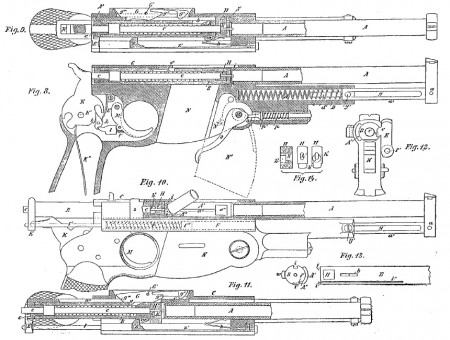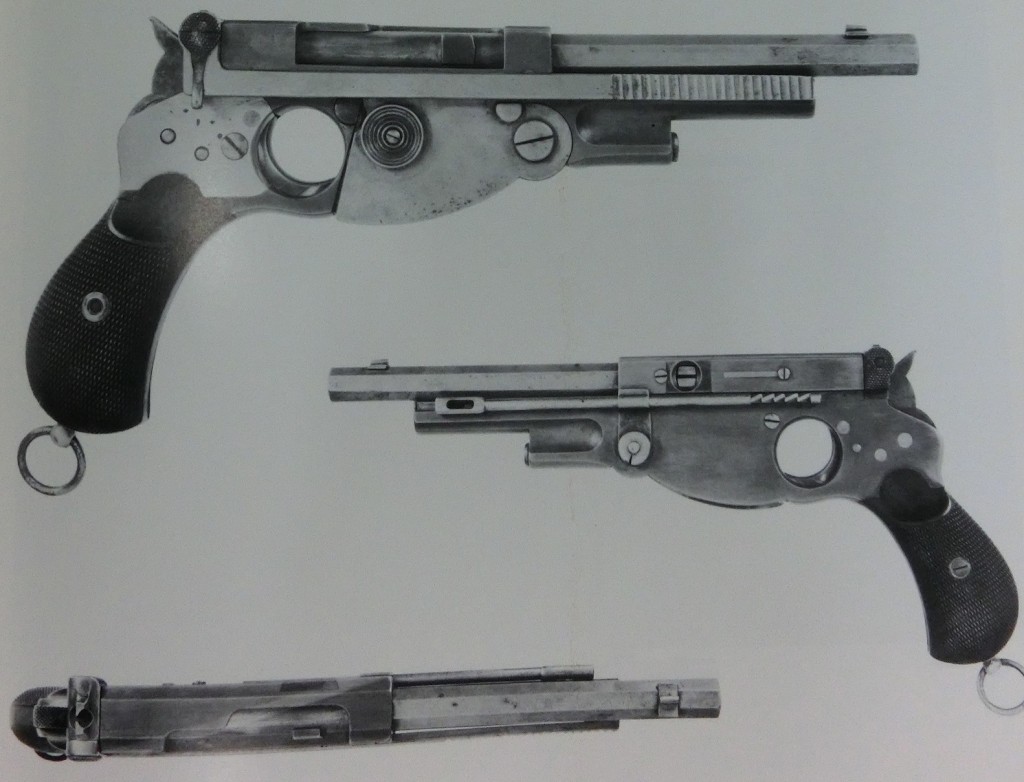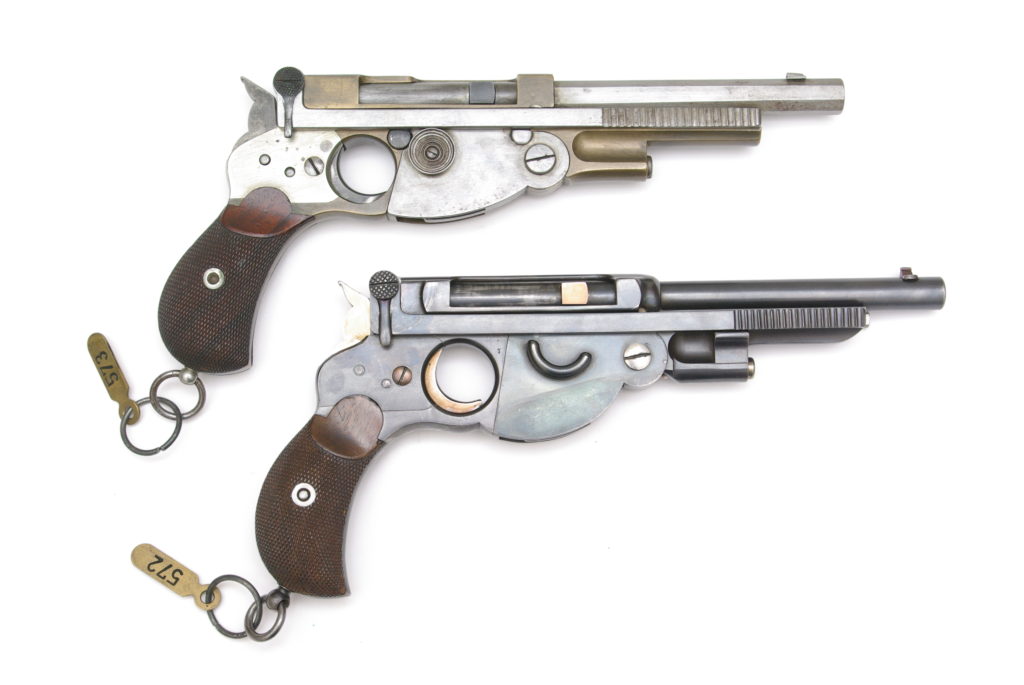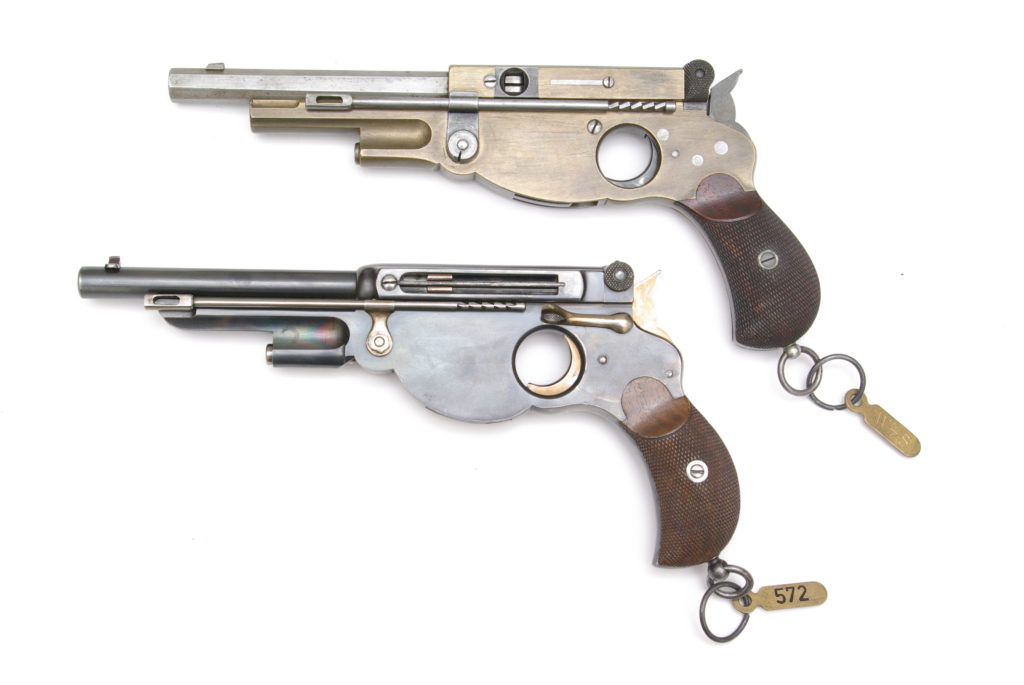Today we are starting the story of the Bergmann automatic pistol – one of the early successful self-loading handguns, and one which led to a less prominent firearms dynasty than some other big names of the time. The story of the Bergmann also has an interesting element of credit to it, as Theodore Bergmann was never a gun designer. Instead, Bergmann was a businessman and industrialist. Born in Spessartdorf Germany in 1850, Bergmann left his family’s innkeeping business to follow a calling in the metalworking industry.
By the age of 19, Bergmann was a managing partner of the Gaggenau Ironworks, which built a wide variety of products, from structural girders to household stoves and also bicycles and airguns. Under Bergmann’s administration, the firm expanded its production of airguns (including licensing a design from the American Henry Quackenbush, whose guns deserve a place on Forgotten Weapons, and who invented the extension ladder at age 16) and also moved into rifles and gun barrels. This put him in a position to be approached by inventors looking for a company to produce new designs – which is exactly what happened.

In 1892, a Hungarian watchmaker by the name of Otto Brauwetter was granted a patent, in conjunction with the Gaggenau company (later to become Bergmanns Industriewerke GmbH), for a self loading firearm mechanism. The assignment of the Gaggenau company to the patent suggests that Bergmann saw potential in the design, and had been willing to invest company time and resources into Brauwetter’s work. The fate of Brauwetter himself with the design is unclear – he seems to disappear from records after that first patent. Instead, the man whom Bergmann finds to refine the patent into a viable production pistol is none other than Louis Schmeisser, who would become a household name in European arms design.

Schmeisser took Brauwetter’s patent and produced the 1893 model pistol from it. The design was a delayed blowback mechanism, using an inclined wedge alongside the barrel.The loading system consisted of a 5-round clip that was inserted in the right side of the pistol after opening a swinging magazine cover plate (this system would feature in several following Bergmann iterations). Interestingly, the pistol also came with its own short cleaning rod stored on the left side under the barrel.
It appears that the gun was built with Swiss military trial in mind, as it was made for the 7.5mm revolver cartridge then in use by the Swiss, and several of the guns were in fact trialed by the Swiss military in 1893.They were very much unsuccessful in those trials, and Schmeisser would go on to significantly modify the design into the Bergmann No. 1 the next year. However, the general layout of this very first design would remain generally unchanged through the whole progression of Bergmann pistols. Unfortunately, there are no known surviving examples of the model 1893 (and only a very few were originally made).
Courtesy of Bas Martens, here are two additional Bergmann-Schmeisser pistols, from the former Waffenfabrik Bern collection, now RUAG:


Technical Specs
Caliber: 7.5mm Swiss Revolver
Clip Capacity: 5 rounds
Overall Length: 11 in (280mm)
Barrel Length: 5.35 in (135mm)
Weight: 34.5 oz (980g)
Action: Delayed blowback
Patents
Swiss Patent 5030 – April 20, 1892
References
Ezell, Edward C. Handguns of the World. Stackpole Books, New York, 1981.
Reinhart, Christian and am Rhyn, Michael. Fastfeuerwaffen II.

http://unblinkingeye.com/Guns/Berg/berg.html
Described the first Bergmann pistol as Model 1892.
Which name is correct – model 1892 or model 1893 or both?
I chose to call it the model 1893 because that is when the pistol was put in Swiss trials (Ezell also refers to is as the model 1893). Calling it the 1892 is also understandable, though, as that is the patent date. They are so obscure (particularly with no surviving examples) that I don’t think there is any sort of officially recognized designation.
So glad I found this web site… as a lifelong fan of the obscure and esoteric it’s a welcome switch from the AR fanboy blather. (At least for someone who would take a Lee-Enfield or K31 over any AR ever made, except for an AR-5 .22 Hornet.) FW has been a fun introduction to, or path toward, fascinating stuff I’d never paid any attention to – and mind you, an old editor used to refer to me as “the king of the obscure reference.” (Granted, he was talking about books and music, not guns, but it’s all part of a whole.) Anyway, until I read this post I’d somehow never paid any attention to the 1882 7.5 Swiss revolver. However, that is now my top pick for Cool Old Gun That Ian Needs To Shoot. Damn, 70+-year service life, including a service-wide arsenal rebuild 30 years after the Luger was adopted, and cool Swiss Cross Bakelite grips. And it’s a left-handed revolver that is as Swiss as a K31! They aren’t nearly as available as the straight-pull rifles but factory ammo is still loaded, so the guns must be around somewhere. Another one for the list….
The Swiss revolvers family include:
M/1872 – rimfire revolver
M/1872-78 – M/1872 altered to fire centerfire ammo
M/1882 – scaled-down M/1872-78 revolver
M/1929 – simplified M/1882 with another grip shape
source: http://www.ordonnanzrevolver.de/schweiz.shtml
Note the simplicity of M/1929 revolver show on photo of disseassembly
http://www.ordonnanzrevolver.de/images/revolver/schweiz/Schweizer-Ordonnanz-Revolver-1929zerlegt.jpg
I miss M/1878 revolver, which was first revolver of mentioned family, designed as center-fire gun (not redesigned rimfire gun).
As a bicycle nut, I especially like the 1929 with the oversize rigid lanyard loop for the Swiss Army Bicycle Corps. The ultimate Velo-Dog!
Looking at the 1882, et al, I’m now curious if the French 1892 was a blatant rip-off of the Swiss ’82 or just had a superficial resemblance. Even though I shoot long guns right-handed, I’ve always been stronger/ more comfortable with handguns in the left (aimed with the right eye) and had a fondness for the anemic old French 8mm. But I now like the Swiss one better. Since Collector’s out on Gessner has dozens of Swiss rifles in stock, I wonder where all the 7.5 mm revolvers are.
http://www.hungariae.com/Gass98.htm
If you like Lebel 1892 revolver, Swiss 1882 revolver, you should also consider Rast & Gasser 1898 revolver. Unique feature of this revolver is 8-round cylinder. It shoots 8mm Gasser ammo (126gr @ 790ft/s), as states: http://en.wikipedia.org/wiki/8mm_Gasser
Who introduced an extractor into the Bergmann pistols? Prior to this improvement, the Bergmann design relied on pure blowback ejection as the cartridge for it had no rim or extractor groove. Bear with me. With no way to extract a stuck cartridge case, the original Bergmann was “reliably unreliable,” the user cursing his luck. Then, BKOOOM! He’s dead from revolver shot.
So much for the en-bloc clip as well, as there is a significant delay for reloading. But then again, stripper clips need more time for loading and require more actions to be performed (insert clip into its guide, strip rounds into magazine, remove clip, release bolt or slide catch). En-bloc clips of Mannlicher design: insert clip. Close action. Fire rounds. Eject clip through bottom, hope you’re not muddy.
Anything missing?
The extractor was added in the 1896 models.
“En-bloc clips of Mannlicher design”
Mannlicher 1895 rifle is loaded with en-bloc clips, but Mannlicher 1905 pistol (last pistol designed by Mannlicher) has integral charger-loaded box-magazine.
http://www.hungariae.com/Mann05.htm
Sorry, I totally forgot about that. I was thinking Steyr-Mannlicher rifle en-bloc clip. But anyways, I should have told you guys that stripper clips for rifles don’t have to be removed by hand. In some cases, slamming the bolts on Mausers, Mosin-Nagants, and Arisakas should eject empty stripper clips very quickly, though you would be doing that during a firefight where worrying about recycling the clips is secondary to having a readied weapon.
If you’re a sniper or designated marksman with a bolt-action, don’t slam the bolt after loading from a stripper clip should your rifle feed from clips, even with a scope. Bolt-slamming clip ejection from a Kar98k is very loud.
“the cartridge for it had no rim or extractor groove”
http://www.russianammo.org/Russian_Ammunition_Page_25mm.html#9a
The idea of rimless & grooveless cartridge is used in Soviet Rikhter R-23 full-auto belt-fed aircraft gun.
http://en.wikipedia.org/wiki/Rikhter_R-23
It has high fire-rate of 1800-2000rpm, it was reliable enough to enter service as Tu-22 tail gun.
Daweo, that only works when there is a back up plan in effect for a revolver cannon! The aircraft-mounted Rikhter cannon doesn’t have the same problems as a hand-held pistol! The Rikhter’s action ejects cartridges forward out of its cylinder probably with gas-operated mechanical ejector but the Bergmann relies on pure blowback to eject rearwards from a chamber. If the grooveless Bergmann cartridge gets stuck, it must be removed by means of cleaning rod or even a twig! Ian, help me out here before Daweo puts 23mm shells through my posts!
Yep, that’s my understanding. It uses that type of case because the mechanism is designed to feed rounds into the front of the cylinder, in order to shorten the overall length of the gun. Feeding from the front like that requires a cylindrical case and a different type of extraction mechanism.
As I understand it, the objective was to reduce the OAL of the cannon to an absolute minimum while retaining the advantage of the Mauser-type revolver-breech system, mainly high ROF while avoiding the extra weight of a Gatling type multiple-barrel design.
The impression I got from the documents at the link (thanks, Daweo!) was that in many respects, the R-23 mechanism was very like that of the Colt Thuer conversion metallic-cartridge revolver of 1865-68.
There was also a British revolver design, the Needham, which worked on similar principles, and which gave birth to a lever-action tubular-magazine repeating rifle of the same name which would be a perfect subject for one of your essays, Ian. Although I doubt you’d ever find enough original ammunition for a live-fire test. 😉
The rifle, BTW, is referenced on p.40 of the tenth (1973) edition of Small Arms of the World, in the historical section. It’s actual mechanism was a peculiar mix of the Henry tubular magazine and a “bar” pistol. (?)(!)
cheers
eon
I find better description of R-23 here:
http://en.valka.cz/viewtopic.php/t/106185
(include photos).
I once had the oppertunity to examin the Brauswetter 1892 pistol, witch still is in the factory collection in Bern. It is a locked breatch desin, with a sideswinhing locking block. the meckanismis saund and efektive
Theextrakter to the 1896 pistol, was aded by Luis Smeisser or perhaps by his son Hugo, both emploied by Bergmann in Gaggenau. somwere I have a note on rhe number pistol that was the first withextraktor.
More Bergman qestions: petermandrasmussen@mail.dk